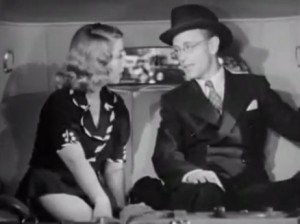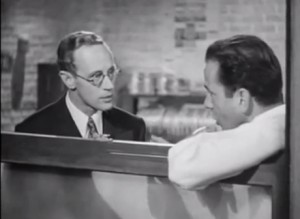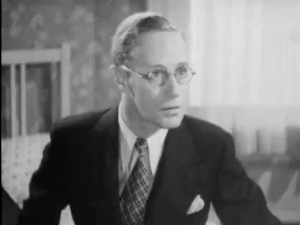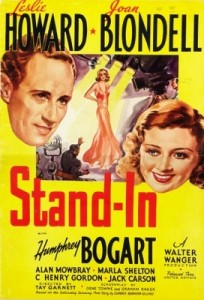“That’s the picture business”- Stand-In (1937)
Stand-In begins with Atterbury Dodd ([intlink id=”546″ type=”category”]Leslie Howard[/intlink]), executive vice president at a Wall Street bank, being sent to Hollywood to investigate one of the company’s underperforming properties, Colossal Studios. The fussy, precise and mathematical Dodd figures that if he just looks at Colossal’s accounting and cuts expenses, he can put the studio in the black. His boss Fowler Pettypacker (Tully Marshall) thinks it’s more trouble than its worth; he wants to sell the studio, for just half what he paid, to financier Ivor Nassau (C. Henry Gordon). Pettypacker cautions Dodd that making the studio profitable is more difficult than the latter thinks it will be, because of “human factors.” Says Pettypacker, “You have unlimited authority. But if you fail, don’t come back.”
 Meanwhile, in Hollywood, we find Nassau and three Colossal employees — faux-foreign director Koslofski (the always-reliable Alan Mowbray), fading star Thelma Cheri (Marla Shelton), and PR flack Tom Potts (Jack Carson) — working together to sabotage Sex and Satan, a Douglas Quintain ([intlink id=”125″ type=”category”]Humphrey Bogart[/intlink]) production. This picture is Colossal’s last chance at success, which is exactly what the four conspirators don’t want. When the studio fails, Nassau will buy it himself at a bargain-basement price, fire all of Colossal’s employees, liquidate the assets, thus making a killing. Of course, he’s told the other three that they’ll get big long-term contracts, so they’ve all been pretty obvious about causing problems for the picture, and Quintain is getting wise.
Meanwhile, in Hollywood, we find Nassau and three Colossal employees — faux-foreign director Koslofski (the always-reliable Alan Mowbray), fading star Thelma Cheri (Marla Shelton), and PR flack Tom Potts (Jack Carson) — working together to sabotage Sex and Satan, a Douglas Quintain ([intlink id=”125″ type=”category”]Humphrey Bogart[/intlink]) production. This picture is Colossal’s last chance at success, which is exactly what the four conspirators don’t want. When the studio fails, Nassau will buy it himself at a bargain-basement price, fire all of Colossal’s employees, liquidate the assets, thus making a killing. Of course, he’s told the other three that they’ll get big long-term contracts, so they’ve all been pretty obvious about causing problems for the picture, and Quintain is getting wise.
Upon his arrival in LA, Dodd is chauffeured in to the studio by a Colossal driver, who also picks up Lester Plum (Joan Blondell). Lester, a former child star, works at the studio as Thelma’s stand-in. Stars are fragile, she tells Dodd, and the stand-ins do the sweating for them. The car drops her at her boardinghouse and continues to Dodd’s $100/day hotel, where Potts is ready to show him a good time. Before he can even start however, Dodd is harassed by a scary stage mom with a Shirley Temple-esque daughter, who breaks out a song and dance on the spot. After threatening to turn the mom over to the juvenile authorities for stealing the girl’s childhood, Dodd flees to Lester’s boardinghouse, which chock-full of the quirky residents you’d expect in a send-up of Hollywood.
 The set-up may seem complex, but it is easier and simpler to understand while watching the film than it is to write about. Stand-In portrays a clash between two points of view — one, represented by Dodd, saying that the people who work at Colossal are just cogs in a machine; the other, epitomized by Quintain and Lester, saying that they’re human beings, with lives just as valuable, maybe more so, than the Wall Street suits who buy and sell them.
The set-up may seem complex, but it is easier and simpler to understand while watching the film than it is to write about. Stand-In portrays a clash between two points of view — one, represented by Dodd, saying that the people who work at Colossal are just cogs in a machine; the other, epitomized by Quintain and Lester, saying that they’re human beings, with lives just as valuable, maybe more so, than the Wall Street suits who buy and sell them.
Stand-In was directed by Tay Garnett, who keeps the story moving at such a good clip with such a light touch that you won’t notice there’s a lot of exposition. He’s working with an excellent cast as well. There’s something really fun about watching Howard play someone so different from his real-life personality. He and Bogart became friends while making The Petrified Forest (1936) and their talents mesh well. But the real revelation, for me anyway, was the chemistry between Howard and Blondell. Howard makes Dodd’s fussiness funny (watching him squirm when Thelma tries to seduce him is hilarious) and his gradual enlightenment believable and plausible. Blondell, a favorite of mine, shows us the hope buried under Lester’s wisecracking exterior and hard-earned cynicism. Very few can deliver a line like, “You’ve got figures in your blood, instead of red corpuscles” as well as Blondell. Dodd is Lester’s ticket out…if he’ll only notice she’s alive and/or female. Together they are superb.
 The title of the film refers to Lester’s job, but also to Dodd, who refers to himself early on as a stand-in for the bank. Their happiness and that of many others depends on their moving past those roles. Essentially this film is a very enjoyable spoof of the Old Hollywood studio system — some of the behind-the-scenes stuff may remind you of Robert Altman’s The Player — and a cautionary tale about unrestrained capitalism — the Great Depression informs the film’s plot. It’s about what can happen on a small scale to ordinary people when greed is allowed to run rampant. We know that then, much like now, if the studio closes, it’ll be difficult for those who are laid off to find a job. Interestingly, according to TCM, the studios’ censor, Joseph Breen, wanted “several changes, ‘including…deleting a speech about the stifling of competition in the industry and the crushing of independent companies by the majors; and deleting a speech by Atterbury at the end, in which he says he is going to start a Senate investigation of the motion picture business.’ [See Stand-In on TCM] In other words, Stand-In is a lot more relatable than any 75-year-old movie has a right to be, and it’s a shame that more people haven’t seen it.
The title of the film refers to Lester’s job, but also to Dodd, who refers to himself early on as a stand-in for the bank. Their happiness and that of many others depends on their moving past those roles. Essentially this film is a very enjoyable spoof of the Old Hollywood studio system — some of the behind-the-scenes stuff may remind you of Robert Altman’s The Player — and a cautionary tale about unrestrained capitalism — the Great Depression informs the film’s plot. It’s about what can happen on a small scale to ordinary people when greed is allowed to run rampant. We know that then, much like now, if the studio closes, it’ll be difficult for those who are laid off to find a job. Interestingly, according to TCM, the studios’ censor, Joseph Breen, wanted “several changes, ‘including…deleting a speech about the stifling of competition in the industry and the crushing of independent companies by the majors; and deleting a speech by Atterbury at the end, in which he says he is going to start a Senate investigation of the motion picture business.’ [See Stand-In on TCM] In other words, Stand-In is a lot more relatable than any 75-year-old movie has a right to be, and it’s a shame that more people haven’t seen it.
The movie has not been released on DVD and is quite rare, but it is on TCM at midnight July 3/4. I highly recommend you check it out.
About our guest: Paula has been a Detroiter since birth and a movie fan since the age of five. She has seen hundreds of classic and contemporary movies. Some of her favorites are Casablanca, The Big Sleep, Diabolique, The Great Escape, and anything by Powell and Pressburger. Her college experience included film and literature coursework and writing film reviews for the campus paper. She can be reached via email at paula.guthat [at] gmail.com and on twitter @Paula_Guthat. She also hosts a great site at Paula’s Cinema Club.

Am going to set my PVR. Thanks!
I wish TCM would show ‘Stand In’ in england. We get basically the same films endlessly repeated.
Apparently the channel is far more adventurous in the states.
Allan Broadfield, London.